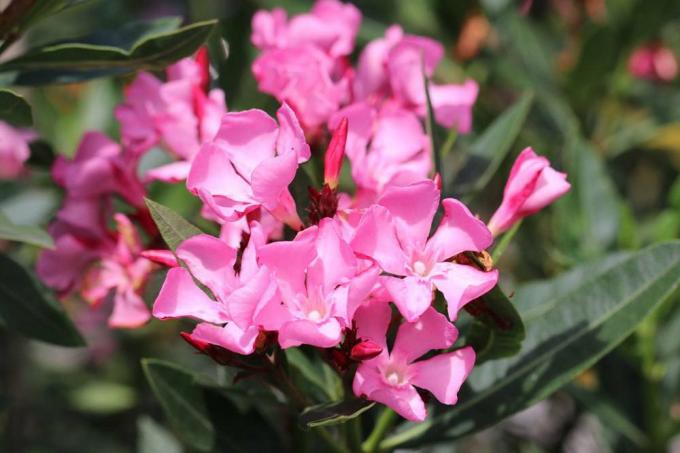
table of contents
- Oleander only tolerates light frosts
- Best possible protection in winter
- Hibernate potted plants frost-free
- Protect from frost outdoors
- What to do in the event of frost damage?
- frequently asked Questions
oleander belongs to the Mediterranean plants. He is used to mild winters with temperatures that are rarely below zero. In Germany it is not hardy. But how sensitive is the oleander to frost?
In a nutshell
- Oleander (Nerium Oleander) is only frost-resistant to a limited extent due to its origin
- very warmth-loving plants that are mainly grown in pots
- It can withstand light frost, temporary cold and snow without any problems
- It usually becomes critical from the middle or end of November
- then it is important to protect the oleander accordingly
Oleander only tolerates light frosts
There is no question that this ornamental wood is not hardy. Nevertheless, it tolerates light frost and temperatures of up to minus five degrees as well as individual night frosts without being damaged. Provided that it is in a sheltered place. As a result, it can easily stay outside until late autumn.

- Do not permanently expose plants that need warmth to frost
- Temperatures below minus five degrees are not tolerated
- as well as prolonged frost with cold easterly winds in the morning
- both result in serious damage
- up to the death of the oleander
- Avoid direct winter sun on the leaves
- Frost damage to the root ball usually cannot be repaired
- Bales freeze through particularly quickly in the bucket
- The plant can no longer absorb water, it dies of thirst
Best possible protection in winter
At the end of the winter break, many plants look quite worn out and need some time to recover. This is usually no different with the oleander. In these cases, pruning can not only be useful, but inevitable. However, this can have a negative effect on flower formation, because this plant mainly flowers on biennial shoots. It is all the more important to ensure the best possible conditions when wintering.
Hibernate potted plants frost-free
Oleanders in the bucket should overwinter in a roost protected from frost. Even if the frost tolerance is rather low, you should leave them outside as long as possible and put them out again as early as possible in spring. This hardens them and helps them to survive the winter well.
An unheated winter garden or a cold greenhouse are particularly suitable as winter quarters. Since this plant retains its leaves even in winter, it should be light, with temperatures between two and ten degrees. If only a dark cellar is available, you have to help with artificial lighting.

Tip: You should avoid pruning before wintering, because the beautiful flowers develop from the freshly formed flower stems in spring. It is advisable to cut back after the first flowering in spring.
Protect from frost outdoors
In very mild and protected locations such as in the Rhine Valley, this Mediterranean plant can also overwinter outdoors under certain circumstances. This applies to planted specimens as well as Potted plants. But only with adequate protection.
- When planting in the bed, cover the root area with leaves and brushwood
- Wrap above-ground parts of the plant with light- and air-permeable fleece
- Airtightness leads to mold and rot
- Place potted plants on a styrofoam plate or wooden pallet
- Wrap the planter with bubble wrap or coconut mat
- put the whole thing in a sheltered place
Tip: The site in winter should be protected from direct winter sun and cold winds as well as rain. Ideally, it should be placed in front of a warm house wall.
What to do in the event of frost damage?
If there is damage from frost, it does not necessarily mean the end of your oleander. If the damage is not too serious, it can be saved in most cases. As long as the roots have not received frost, it usually sprouts again.

- Leaves usually damaged first
- only then do twigs, larger branches and finally the trunk follow
- clear warning signs are shoots that look brown and dry
- As an immediate measure, cut off frozen leaves and twigs
- In the case of major frost damage, more severe pruning is recommended
- Cut entire plants about halfway down
How badly the plant is ultimately damaged can be tested by nibbling off some of the bark. If it is still green behind it, this part has not frozen to death. But if it is woody brown behind the bark, the affected twig or branch must be cut off.
frequently asked Questions
Overwintering outdoors is only possible, if at all, in regions with mild winter frost and light frost. This is the case in the Rhineland, on the Lower Rhine, in the southwest and especially in wine-growing areas. However, appropriate protection should not be dispensed with.
If possible, the inflorescences should not be cut off, provided that there is no disease or pest infestation. If you cut them off, you also remove the flower systems that have formed there for the next year. There would be no bloom in the following year. Usually they fall off all by themselves.
Yes, both specimens in winter quarters and those outdoors. Plants that are outside in winter should only be watered on frost-free days and not too much. Waterlogging should be avoided with both variants.



